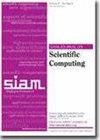多项式度最佳复杂度的德拉姆复数多网格求解器
IF 2.6
2区 数学
Q1 MATHEMATICS, APPLIED
引用次数: 0
摘要
SIAM 科学计算期刊》,第 46 卷第 3 期,第 A1549-A1573 页,2024 年 6 月。 摘要。在构建更复杂问题的快速预处理时,[math] de Rham 复数的 Riesz 映射经常作为子问题出现。在这项工作中,我们提出了对这些里兹图进行高阶有限元离散化的多网格求解器,其时间和空间复杂度与和因式化算子应用相同,即在克雷洛夫方法背景下具有多项式度的最佳复杂度。我们方法的关键思路是为 de Rham 复数中的每个空间建立新的有限元,这些有限元在[math]-和[math]-内积(参考六面体上的[math])中都具有正交性。由此产生的稀疏性使得在可分情况下,帕瓦里诺、阿诺德-福尔克-温特和希普迈空间分解中出现的补丁问题得以快速解决。在不可分离的情况下,该方法可用于构造稀疏的辅助算子。通过对稀疏补丁问题进行精确的 Cholesky 因子分解,应用复杂度达到最佳,但设置成本和存储成本却不尽人意。我们通过更精细的 Hiptmair 空间分解和使用不完全的 Cholesky 因子分解来克服这一问题,不完全的 Cholesky 因子分解施加了由静态压缩产生的稀疏性模式,无论求解器是否使用静态压缩,这种模式都适用。这就产生了多网格松弛,其时间和空间复杂度在多项式程度上都是最优的。计算结果的可重复性。本文被授予 "SIAM 可重现徽章":代码和数据可用",以表彰作者遵循了 SISC 和科学计算界重视的可重现性原则。读者可以通过 https://doi.org/10.5281/zenodo.7358044 和补充材料(pmg_de_rham.zip [61.2KB])中的代码和数据重现本文的结果。本文章由计算机程序翻译,如有差异,请以英文原文为准。
Multigrid Solvers for the de Rham Complex with Optimal Complexity in Polynomial Degree
SIAM Journal on Scientific Computing, Volume 46, Issue 3, Page A1549-A1573, June 2024.
Abstract. The Riesz maps of the [math] de Rham complex frequently arise as subproblems in the construction of fast preconditioners for more complicated problems. In this work, we present multigrid solvers for high-order finite-element discretizations of these Riesz maps with the same time and space complexity as sum-factorized operator application, i.e., with optimal complexity in polynomial degree in the context of Krylov methods. The key idea of our approach is to build new finite elements for each space in the de Rham complex with orthogonality properties in both the [math]- and [math]-inner products ([math] on the reference hexahedron. The resulting sparsity enables the fast solution of the patch problems arising in the Pavarino, Arnold–Falk–Winther, and Hiptmair space decompositions in the separable case. In the nonseparable case, the method can be applied to an auxiliary operator that is sparse by construction. With exact Cholesky factorizations of the sparse patch problems, the application complexity is optimal, but the setup costs and storage are not. We overcome this with the finer Hiptmair space decomposition and the use of incomplete Cholesky factorizations imposing the sparsity pattern arising from static condensation, which applies whether static condensation is used for the solver or not. This yields multigrid relaxations with time and space complexity that are both optimal in the polynomial degree. Reproducibility of computational results. This paper has been awarded the “SIAM Reproducibility Badge: Code and data available” as a recognition that the authors have followed reproducibility principles valued by SISC and the scientific computing community. Code and data that allow readers to reproduce the results in this paper are available at https://doi.org/10.5281/zenodo.7358044 and in the supplementary materials (pmg_de_rham.zip [61.2KB]).
Abstract. The Riesz maps of the [math] de Rham complex frequently arise as subproblems in the construction of fast preconditioners for more complicated problems. In this work, we present multigrid solvers for high-order finite-element discretizations of these Riesz maps with the same time and space complexity as sum-factorized operator application, i.e., with optimal complexity in polynomial degree in the context of Krylov methods. The key idea of our approach is to build new finite elements for each space in the de Rham complex with orthogonality properties in both the [math]- and [math]-inner products ([math] on the reference hexahedron. The resulting sparsity enables the fast solution of the patch problems arising in the Pavarino, Arnold–Falk–Winther, and Hiptmair space decompositions in the separable case. In the nonseparable case, the method can be applied to an auxiliary operator that is sparse by construction. With exact Cholesky factorizations of the sparse patch problems, the application complexity is optimal, but the setup costs and storage are not. We overcome this with the finer Hiptmair space decomposition and the use of incomplete Cholesky factorizations imposing the sparsity pattern arising from static condensation, which applies whether static condensation is used for the solver or not. This yields multigrid relaxations with time and space complexity that are both optimal in the polynomial degree. Reproducibility of computational results. This paper has been awarded the “SIAM Reproducibility Badge: Code and data available” as a recognition that the authors have followed reproducibility principles valued by SISC and the scientific computing community. Code and data that allow readers to reproduce the results in this paper are available at https://doi.org/10.5281/zenodo.7358044 and in the supplementary materials (pmg_de_rham.zip [61.2KB]).
求助全文
通过发布文献求助,成功后即可免费获取论文全文。
去求助
来源期刊
CiteScore
5.50
自引率
3.20%
发文量
209
审稿时长
1 months
期刊介绍:
The purpose of SIAM Journal on Scientific Computing (SISC) is to advance computational methods for solving scientific and engineering problems.
SISC papers are classified into three categories:
1. Methods and Algorithms for Scientific Computing: Papers in this category may include theoretical analysis, provided that the relevance to applications in science and engineering is demonstrated. They should contain meaningful computational results and theoretical results or strong heuristics supporting the performance of new algorithms.
2. Computational Methods in Science and Engineering: Papers in this section will typically describe novel methodologies for solving a specific problem in computational science or engineering. They should contain enough information about the application to orient other computational scientists but should omit details of interest mainly to the applications specialist.
3. Software and High-Performance Computing: Papers in this category should concern the novel design and development of computational methods and high-quality software, parallel algorithms, high-performance computing issues, new architectures, data analysis, or visualization. The primary focus should be on computational methods that have potentially large impact for an important class of scientific or engineering problems.

 求助内容:
求助内容: 应助结果提醒方式:
应助结果提醒方式:


